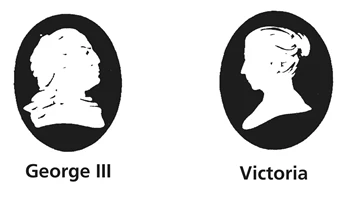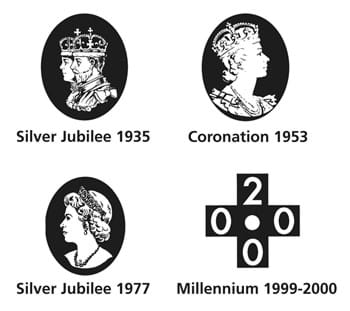A Beginner's Guide to Hallmarks
If you are interested in purchasing antique jewellery or solid silver collectables, then a basic knowledge of hallmarks will stand you in good stead. At Top Banana Antiques we have written a hallmark guide which will tell you everything you need to know.
What is a Hallmark?
A hallmark, or assay mark, is an official mark or series of marks struck on items made of metal, mostly to certify the content of noble metals - such as platinum, gold, silver and most recently, palladium. It is considered one of the earliest forms of consumer protection, as hallmarked items are tested, authenticated and marked at assay offices.
A hallmark:
- Consists of a series of marks applied to articles of the precious metals platinum, gold, palladium and silver
- Means that the article has been independently tested
- Guarantees that it conforms to all legal standards of purity (fineness)
- Guarantees provenance by telling us, as a minimum legal requirement, where the piece was hallmarked, what the article is made from, and who sent the article for hallmarking.


Examples of modern and Victorian hallmarks
The History of British Hallmarks
The earliest known English hallmark dates back to 1300 A.D. when King Edward I of England enacted a statute requiring that all silver articles must meet the sterling silver standard (92.5% pure silver) and must be assayed in this regard by 'guardians of the craft' who would then mark the item with a leopard's head. In 1327 King Edward III of England granted a charter to the Worshipful Company of Goldsmiths (more commonly known as the Goldsmiths' Company, which still exists today), marking the beginning of the Company's formal existence. The official 'Assay Office' within Goldsmith's Hall opened in London 1478.
Town Marks
In later years, other assay offices were opened. Today there are still offices in Edinburgh, where hallmarking has been regulated since the 15th century, and in Birmingham and Sheffield in 1773. Dublin’s assay office has been operating since the middle of the 17th century and silver is still marked there.
Often, items which carry hallmarks from an Assay office which is no longer operating are quite sought after, for example Chester, which closed in 1962, or York, which closed in 1856.
Since hallmarking began, the leopard’s head has been used in various forms to denote the London Assay Office. The Edinburgh mark is a three-turreted castle (to which a thistle was added from 1759 until 1975 when a lion rampant replace the thistle); the mark for Sheffield was a crown until 1974 when it was replaced by a rosette, while the symbol for silver made in Birmingham is an anchor.

Town Marks for London, Birmingham, Sheffield and Edinburgh
Scottish and Irish Provincial Silver
For many reasons town silversmiths in Ireland and Scotland seldom sent their plate to Edinburgh, Glasgow or Dublin to be assayed. Here, often for reasons of security and economy, it was prudent to operate outside the jurisdiction of the metropolitan assay houses of Dublin and Edinburgh.
Instead, they stamped the silver themselves with a maker's mark, a town mark or combinations of these and other marks.
Rarity dictates that Scottish/Irish provincial silver is highly collectable, most obviously in the flatware and hollow wares produced in provincial Ireland and Scotland.
Date Letters
Although no longer compulsory, British hallmarks typically include a letter to indicate the year when a piece of silver was assayed. Generally the letter was changed annually until a complete alphabet had been used and then the cycle would begin again with an alteration to the style of letter or its surrounding shield. For a variety of reasons this practice was not always adhered to and the resulting anomalies can be seen in the tables of marks.
However, the date letter system allows antique plate to be dated more accurately than almost all other antiques.
Since 1999 the inclusion of a date letter has not been compulsory.
Makers' Marks
The company or person responsible for sending a silver article for hallmarking has their own unique mark that must be registered with the assay office – a process that has been compulsory since the 14th century.The inclusion of initial stamps alongside the hallmarks means that most makers can also be identified.

Traditional Fineness And Standard Marks
Hallmarked items will have a numerical stamp on them, denoting purity of the metal in parts per thousand. Sterling silver, for example, is 92.5% pure (the remaining 7.5% being metal alloys) and therefore stamped 925, 9ct gold is 37.5% pure and stamped 375, 18ct gold 75% pure and therefore stamped 750. In order to avoid confusion, often the fineness mark's shape will also denote the metal, for example, silver is within an oval shape (see below).

Additional Fineness Marks
Historically the standard mark for sterling (.925 purity) silver in Britain has been a lion passant and this will be found on the majority of pieces. However, in 1696, rising concerns over the amount of coinage being melted down and used to make silver items meant that the required fineness was raised to the higher Britannia standard (.958 purity).
This measure was continued until 1720 and all silver marked between those two dates bore a lion’s head and the figure of Britannia in place of the lion passant.
Gold was also hallmarked with a crown symbol, and more recent introductions are the centurion head for palladium and the orb for platinum. Today, these marks are optional, not compulsory.

Duty Marks
Many items of Georgian and Victorian silver will carry a sovereign’s head – a ‘duty’ mark reflecting a tax on precious metals collected between 1784 and 1890. The excise duty on gold and silver articles was collected by the assay offices and the mark was struck to show that it had been paid. Two examples are shown below.
Commemorative Marks
Special commemorative stamps have been added to the regular silver marks to mark special events. In addition to the four examples shown below, the head of Elizabeth II facing right was used to mark her Golden Jubilee in 2002 and another set in a diamond was used from July 2011 to October 1, 2012, to mark the Diamond Jubilee.
The UK Hallmarking Act 1973
The Hallmarking Act 1973 made Britain a member of the Vienna Convention as well as introducing marking for platinum, a recognised metal under the Convention. As it now stands, the compulsory part of the UK hallmark consists of the sponsor or maker's mark, the assay office mark, and the standard of fineness (in this case silver, 925 parts in 1000). The Hallmarking Act was amended in July 2009 to include palladium from January 2010.
European Marks
Since 1972 the United Kingdom has been a signatory to the International Convention on Hallmarks. Silver marked in Convention countries bears a maker’s mark, a common control mark, a purity mark and a country mark. Nine examples of country marks are shown here.
Top Banana Antiques - Your Friendly Hallmark Experts
If you own a hallmarked item and are curious to find out more, bring it into Top Banana Antiques and we can look up the hallmark for you. Alternatively, you can find date letter tables here:
1 Response
Leave a comment
Comments will be approved before showing up.






Hayley
June 11, 2020
This is a really good guide, thank you :)